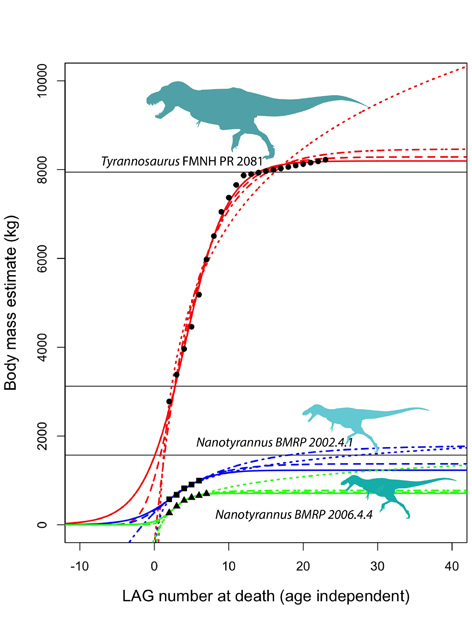Newly published research suggests that the Nanotyrannus genus is valid. Writing in the academic journal “Fossil Studies” researchers conclude that Nanotyrannus lancensis is a distinct species and that fossil specimens do not represent juvenile examples of Tyrannosaurus rex.

Nanotyrannus lancensis and Tyrannosaurus rex
The scientists, Dr Nick Longrich, from the Milner Centre for Evolution at the University of Bath and Dr Evan Saitta, from the University of Chicago propose that Nanotyrannus was probably not closely related to T. rex. Their research indicates that Nanotyrannus was a smaller, longer-armed tyrannosaur with a narrower snout.
The debate as to the validity of Nanotyrannus as a taxon has persisted for decades. The first skull assigned to Nanotyrannus was found in Montana in 1942. Analysis of a skull bone from a previously unrecognised T. rex fossil coupled with a detailed bone histology demonstrates that specimens of N. lancensis do indeed represent adult animals and not juveniles of another, already described species.
The research led Longrich and co-author Evan Saitta to a previous fossil discovery. The skull bone is a frontal, it was at a museum in San Francisco but had not been studied. The researchers were able to conclude that this frontal came from a juvenile T. rex, an animal that would have had a skull about 45 cm long and a body length of 5 metres.
Dr Longrich explained:
“Yes, it’s just one specimen, and just one bone, but it only takes one. T. rex skull bones are very distinctive, nothing else looks like it. Young T. rex exist, they’re just incredibly rare, like juveniles of most dinosaurs.”
Comparing Growth Rates
Measuring the growth rings in Nanotyrannus bones, the researchers demonstrated that they became more closely packed towards the outside of the bone – its growth was slowing. It suggests these animals were nearly full size, not fast-growing juveniles. Modelling the growth of the fossils showed the animals would have reached a maximum of around 900-1500 kilograms and five metres – about 15 per cent of the size of the giant T. rex, which grew to 8,000 kilograms and twelve metres long or more.

Dr Longrich commented:
“When I saw these results, I was pretty blown away. I didn’t expect it to be quite so conclusive.”
He added:
“If they were young T. rex they should be growing like crazy, putting on hundreds of kilograms a year, but we’re not seeing that. We tried modelling the data in a lot of different ways and we kept getting low growth rates. This is looking like the end for the hypothesis that these animals are young T. rex.”

No Evidence of Fossils with Combined Traits
In addition, the researchers found no evidence of fossils combining features of both the Nanotyrannus and T. rex, which would exist if the one transitioned into the other. Every fossil they examined could be confidently identified as one species or the other. Neither did the patterns of growth in other tyrannosaurs fit with the hypothesis that Nanotyrannus fossils were juvenile T. rex.
The picture (above) shows a replica of Nanotyrannus lancensis in the PNSO model range.
To view this range of dinosaur models: PNSO Age of Dinosaurs.
Nanotyrannus lancensis – Strong Evidence in Support of this Genus
Dr Longrich said:
“If you look at juveniles of other tyrannosaurs, they show many of the distinctive features of the adults. A very young Tarbosaurus – a close relative of T. rex – shows distinctive features of the adults. In the same way that kittens look like cats and puppies look like dogs, the juveniles of different tyrannosaurs are distinctive. Nanotyrannus just doesn’t look anything like a T. rex. It could be growing in a way that’s completely unlike any other tyrannosaur, or any other dinosaur- but it’s more likely it’s just not a T. rex.”
The researchers argue these findings are strong evidence that Nanotyrannus is a separate species, one not closely related to Tyrannosaurus. It was more lightly-built and long-limbed than its thick-set relative. It also had larger arms, unlike the famously short-armed T. rex.
Furthermore, the authors suggest that, given how difficult it is to tell dinosaurs apart based on their often-incomplete skeletons, palaeontologists may be underestimating the diversity of dinosaurs, and other fossil species.
Everything Dinosaur acknowledges the assistance of a media release from the University of Bath in the compilation of this article.
The scientific paper: “Taxonomic Status of Nanotyrannus lancensis (Dinosauria: Tyrannosauroidea) — A Distinct Taxon of Small-Bodied Tyrannosaur” by Nicholas R. Longrich and Evan T. Saitta published in Fossil Studies.
Visit the Everything Dinosaur website: Everything Dinosaur.








Nanotyrannus egg on the face of some of the overconfident deniers of Nano,
Lions share their habitat with many smaller predators including other cats, and whilst it is likely that there was still a degree of niche partitioning between adults and juveniles in T. rex, it also undoubtedly also shared its habitat with smaller cousins. Given that it’s very difficult to identify differences in many modern species from skeletal remains alone, and taking into account the fragmentary and distorted nature of many dinosaur remains, and issues with precision in their temporal placement, I’m inclined to think it’s wise to remain open-minded about the possibility that we are misidentifying closely-related species of dinosaur as the same species, rather frequently. This is very much a cautionary tale against seeing what we want to with few facts to hand, as opposed to what is really there. It may of course come full-circle again, like Brontosaurus!